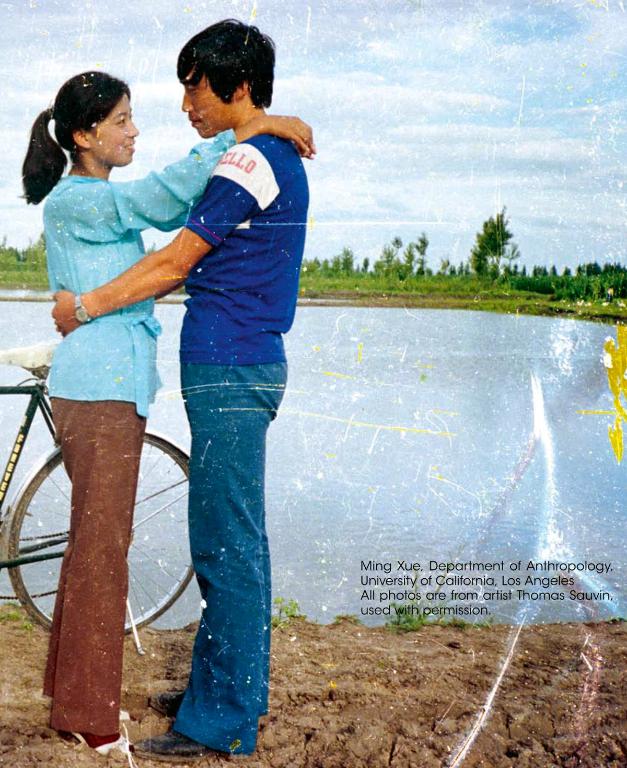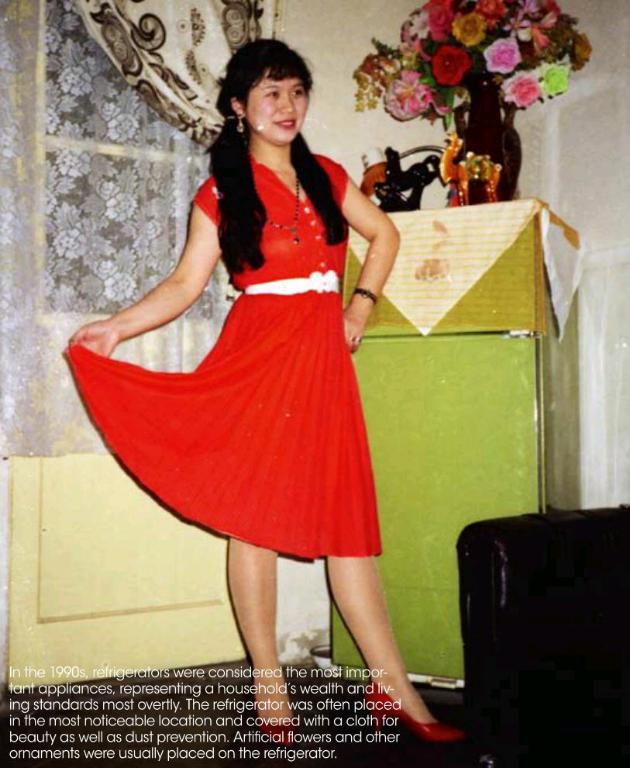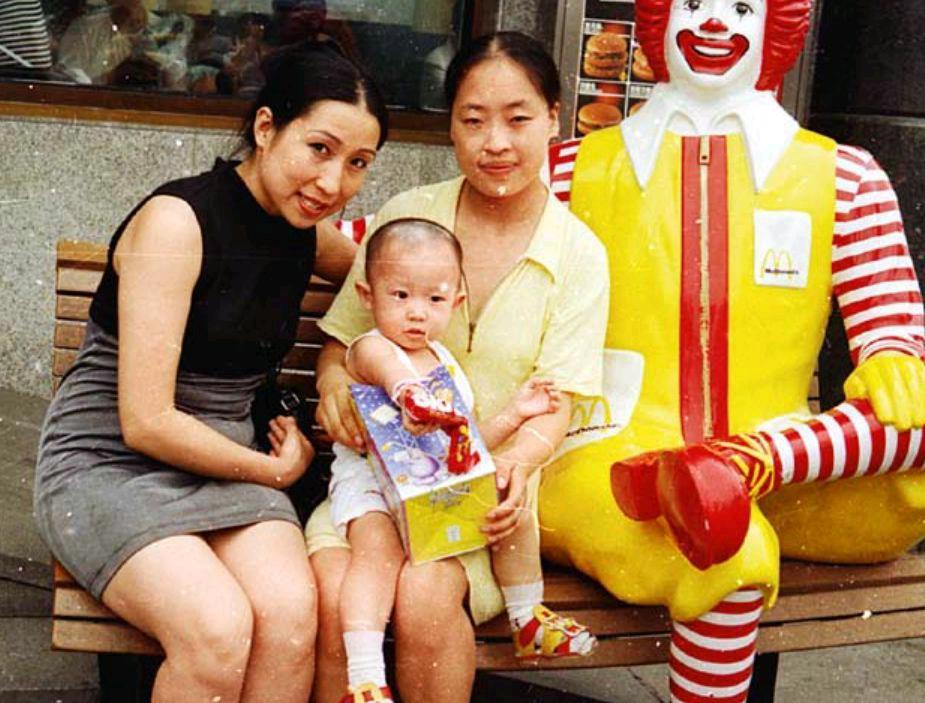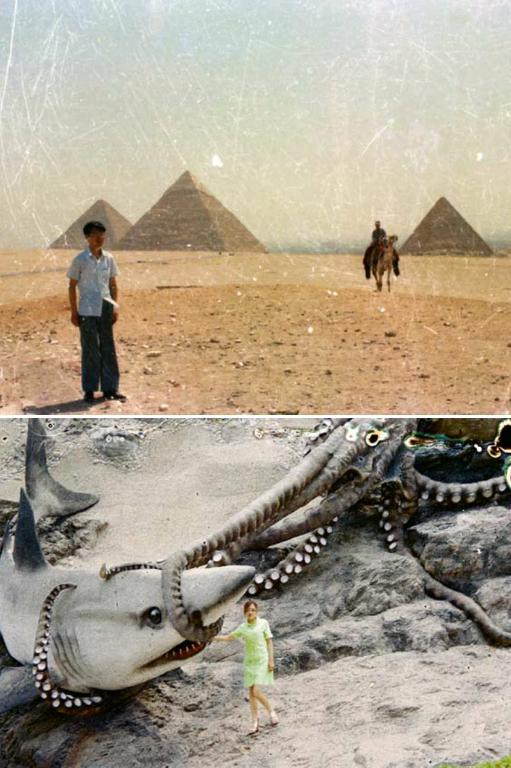Beijing Silvermine:Nostalgia from Negatives
By+Ming+Xue

Thomas Sauvin hails from France, and has been living in China for years. Sauvin does not think he is an artist. Instead, he recognizes himself as a curator, collector, and archivist.
When he first came to China, he became interested in historical photos of China, and began collecting some albums. In 2009, Sauvin met a guy named Ma by chance, who was working in the recycling zone in Beijing and specialized in recycling trash that contained silver nitrate. The trash usually consisted of x-rays from hospitals, CDs, and also negatives. Ma put everything in a pool of liquid acid and waited for a week until the silver nitrate subsided. He then collected the silver nitrate and sold it to chemists.
Sauvin was heartbroken to see this as a photography collector. He decided to ask Ma to sell the negatives to him by the kilo. The first time, Ma sold him a huge bag of negatives weighing almost 50kg. From then on, Ma called Sauvin every one or two months when he found negatives. Over the following four years, Sauvin continued collecting all the negatives from Ma, and has now amassed over 650,000. It is the “Beijing Silvermine”.
Unedited Portrait of China
Of all the negatives, the earliest can be dated back to the early 1980s, and most were taken before 2005, when digital cameras replaced film in China. Beijing Silvermine is a unique documentation of changes in the lives of ordinary residents in Beijing. Through the large-scale collection, Sauvin began to unveil an unedited portrait of China across twenty years since the beginning of reform and opening-up.
Since January 11, 2014, Beijing Silvermine has been on display at the 4A Center for Contemporary Asian Art in Sydney.
The exhibition aimed to create a real-life experience for the audience, with photos revealing changes in material goods, entertainment, the landscape of the city, and ordinary lives of the residents in Beijing across twenty years. The unedited photos of ordinary people easily evoked memories and offered an impressive experience for spectators.
One standout is a photo of a woman in red dress standing in front of a refrigerator. I immediately recognized the Snow brand refrigerator, which every home seemed to have. I also recognized the exact same curtain, the tricolor glazed horse sculpture, and fake flowers on the refrigerator as we also had before. The curtain, the horse, and the fake flowers frequently appeared in many other photos.
In initial stage of reform and opening-up, the material situation of Chinese people had began improving. Around 1985, film became popular with regular people in China. People began to use the camera to document every little change in their lives, such as a new refrigerator, a color TV, a new amusement park, flowers in Tiananmen Square, or the first time dining at McDonalds.
When we look back, we become amused by ourselves at that time: people all fell in line, buying the exact same refrigerator, washing machine, curtain or calendar for their homes, posing with similar smiles in front of the flower beds, or sitting in the same place with “Uncle McDonald” outside the restaurant.
Twenty years ago, even in cities like Beijing, people still had limited options of commercial goods or entertainment to choose from. Such homogeneity, which seems a bit funny to us right now, was quite common and reasonable at that time. Only when we look back at the large quantity of photos of ordinary people can we realize how much China has changed over the past thirty years.
The Shrinking Family Photo
Sauvins collection covers another important period of China. Under huge population pressure, the family plan policy was officially enacted in 1979. The policy required each registered household in urban cities to have only one child. So it was also known as “One-Child Policy”. The family plan policy did not only affect the size of population, but also changed the family composition, age structure, and philosophy of Chinese people. Traditional close-bonded extended families were gradually replaced by more isolated and autonomous nuclear families.
Children who were born during this period usually faced two extremes: on one hand, the child was the focus of six people of two generations, including the parents and grandparents. On the other hand, without brothers or sisters as intimate cohorts, the child usually appeared to be quite lonely at home. As the material conditions improved during the same time period, the changes in family structure and consumption attitudes intertwined and facilitated the transition of China, from a collective culture to a more materialized and individualized culture.
At the beginning of such a transition, parents were very generous in using film to document every moment of their childs life. Because of “one-child,” the ordinary experience of family life became singular and precious. Thirty-five years have passed since the implementation of the family plan policy. When I look at these family photos, especially those taken during Chinese New Year with many family members gathering together, I wonder how much family photos of Chinese people have been shrinking.
The Rise of Individualism
The implementation of reform and opening-up in China has also introduced individualism and consumerism of capitalist economies of Western countries. With improvements in material life as well as changes in family structures, Chinese people also experienced considerable shifts in their personalities: from emphasis on collectivism to individual, from uniformity to nonconformity, from humble and cautious to open and even ostentatious.
McDonalds is a very popular subject among Sauvins collection. Professor Yunxiang Yan at the University of California, Los Angeles, provided an interesting discussion on how American culture influenced Chinese people in a thesis about the rise of individualism in China. He pointed out that McDonalds did not only bring a drastically different diet, but also created a public sphere that had never existed in China — a sphere where each individual could keep his privacy while dining in a restaurant.
Quite different from other Chinese restaurants at that time, customers did not have to eat in a hurry or leave immediately after eating at McDonalds. Even just ordering milk, a customer was able to sit in the restaurant for the whole afternoon without causing scrutiny or gossip from waiters or other customers. If you purchase the food, you have the right to enjoy the public sphere and all facilities in the restaurant.
Such a novel public sphere released individuals from their closely bonded collective lives at home and work, and attracted many young people in China including students, close friends, and romantic couples. The slogan of McDonalds, “Im lovin it”, indicates strong and even willful pursuit of individuality.
Along with emphasis on individuality, Chinese people of this period showed different views on consumerism from the older generations. They valued quality of life and personal happiness more than savings. They began spending money on travel, exotic food, movies, karaoke, or other entertainment. According to Sauvin, when he glanced at the photos over time, he began to notice that people first traveled around China, and then made trips abroad. First to Thailand, Singapore, and Malaysia, then their footprints reached Paris, London, and New York.
A Map of the Disappeared City
A map of the disappeared city is hidden in Sauvins collection. Over the past 30 years, dramatic changes have taken place in Beijing. From 2nd Ring Road all the way to 7th Ring Road, the city has been ambitiously expanding. Highways, overpasses, subways, and high-rise buildings filled every nook of the city.
Meanwhile, people from other places in China have been pouring into the capital. It is estimated that nearly 600,000 people migrate to Beijing each year. To afford the expansion of population, more and more high-rise apartment buildings were constructed, along with shopping malls, luxury hotels, and fancy restaurants. During this process, narrow hutong and quadrangles, along with the traditional style of life in Beijing, have been relentlessly replaced.
Many residents in Beijing clearly remember sounds that they used to hear during their childhood: the junk collectors riding carts by, homing pigeons hovering above neighbors sycamore trees, the clack of retired men playing chess on the street, and the crunchy fried bread emerging from boiling oil in early mornings. However, it seems that all of a sudden, the sounds disappeared.
Beijing has been moving forward too fast for residents to recall the details of the changes or be aware of the scale of the change. Jeremie Descamps, a French urban planner specializing in the city of Beijing, noticed Sauvin collection. He decided to locate old landmarks of Beijing in Sauvins photos and contrast them with what they look like right now. He wanted to understand and reveal what had not changed much and what had completely disappeared from the map of Beijing.
Vivid Memories of China on Negatives
When Sauvin presented his collection to spectators in China and abroad, he encountered very different responses. When he held exhibitions in overseas countries, attendees were surprised by what they saw. These images bare little relation to what Western audiences might perceive about China. In the initial stage of reform and opening-up, the Chinese government tried to build and promote a positive image of the country to the West. In contrast, during the Cold War, the Western media particularly picked on socialist countries and was keen on reporting news of corruption, destruction, or pollution in China. Neither of these voices could fully represent such a huge and diverse country. Ordinary individuals and families were largely ignored.

Sauvin pointed out that his collection revealed a portrait of China in the early stage of socialism, when the influence of the“cultural revolution” was still visible. He did not consider it an easy time for China. However, he found the unexpected: a lot of happy smiles, a lot of relaxing and satisfying family times. Spectators in foreign countries had not expected that either.
More importantly, the photos were not taken by professional photographers. They came from different individuals and from hundreds and thousands of ordinary families in China. They are rooted in people. In addition, Sauvin did not choose photos from particular families. He rescued the photos from destruction. The random large-scale collection creates an astonishing visual experience when you see the same refrigerator repeatedly in different photos or many different people making the same pose in front of Tiananmen Square.
Sauvins collection triggers great curiosity from outsiders to understand China, as well as people living in the country. The ordinary images effectively bridge communication across cultures.
Interestingly, when Sauvin showed the photos to some middleaged Chinese people, they thought the photos were boring and banal. They responded, “You like these photos? I have a lot of them at home!” In contrast, young adults born in the 1980s were intrigued. Possibly, the photos brought back memories of their carefree childhood, or energetic and romantic teenage years.
Sauvin did not expect the consistent responses he received from attendees. He was very impressed when the almost-trashed negatives brought back memories, facilitated conversation, and bridged understanding. He treasures the opportunity to share these photos with others because he considers it unhealthy for him to be the only one digesting them with his own taste and emotions.
In 2013, Lianzhou Foto presented the New Photography Award of the Year to Sauvin. Sauvin revealed that some committee members suggested that the award should go to someone Chinese, not French. Ultimately, however, the award still went to Sauvin with the comment that, “Giving the award to Sauvin is giving it to passion. However, Sauvin considered himself lucky to have dug up Beijing Silvermine first, because no other place in the world could encompass such diversity within a country, and no other place could match such extraordinary change within such a short period of time.
Asked what he planned for the future, Sauvin smiled and noted that although Beijing Silvermine had been exhibited in places such as Singapore, England, Australia and U.S.A. as well as Hong Kong, it had not met its hometown yet. He hopes to hold an exhibition in Beijing in 2014. It would surely be a fruitful and unforgettable experience for him and for the audience. Its got to be here.

